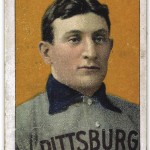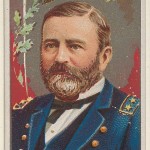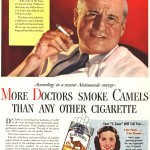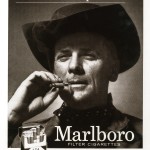While medical research has identified nicotine as the leading culprit behind widespread cigarette addiction, “advertising is often singled out as an important causal determinant of cigarette consumption.”[1] For over two hundred years, cigarette manufactures have aggressively competed for valuable market share within an incredibly lucrative American tobacco industry. Initially, “tobacco companies used trade cards, tin tags and posters to advertise their products,”[2] yet as technology advanced and new mediums of advertisement were introduced, cigarette advertisements adapted and were featured on increasingly sophisticated media platforms. Cigarette advertisements evolved from the simplicity of black and white trade cards towards print, radio, television, sports/event sponsorships, direct mail advertising, and Internet marketing.
Trading Cards:
First introduced by “French tradesmen to customers or potential clients as a means of advertising,”[3] colorful and detailed cigarette trading cards became an important component of early American cigarette advertising. Trading cards featuring sports heroes, beautiful women, and iconic individuals were included in cigarette packs throughout the late 19th and early 20th century, as a means of connecting with customers and building brand loyalty. These cards were effective tools in incentivizing customers to limit their purchases of cigarettes to a specific brand (doing so allows one to complete the set of highly coveted trading cards). Despite the early success of cigarette trading cards, the “heyday of tobacco-sponsored trading cards ended after World War II”[4] as more modern and effective forms of advertising emerged (print, radio).
Print Ads:
In the 1920s and 1930s, cigarette ads shifted away from traditional trading cards, and were predominantly featured in newspapers and magazines. Advertisement campaigns in this era “extolled the healthy virtues of cigarettes,”[5] and featured “full-color magazine ads depicting kindly doctors clad in white coats proudly lighting up or puffing away.”[6]
Magazines and newspapers were an effective outlet for product advertisement as they offered tobacco brands the opportunity to target a greater number and variety of potential customers. Through print advertisements, cigarette brands employed a plethora of clever slogans, imagery, themes, and narratives to persuade consumers to buy their line of products.
Despite the introduction and implementation of significant government regulation that discourages cigarette promotion and advertisement, cigarette and tobacco-related products continue to be featured in a variety of publications in print-form.
Radio:
Radio-based cigarette advertisements were common in the 1940s and 1950s, but have since become illegal as a result of the 1970 Public Health Cigarette Smoking Act. This act was a significant step in the suppression of cigarette advertising in America as it banned all manufactures and brand from marketing their products on TV and radio.
Television:
Similar to radio, television advertisements were prohibited domestically as a result of the Public Health Cigarette Smoking Act in 1970. Television-based promotions and advertisements that previously glorified and encouraged smoking have since been replaced by aggressive anti-smoking campaigns (sponsored by organizations such as the CDC) that invoke fear within smokers and non-smokers. While current anti-smoking commercial are graphic and disturbing, they provide a strong message to youth and current smokers that cigarette consumption will inevitably deteriorate your health, and negatively transform your life.
[1] Nelson, Jon P. “Cigarette Advertising Regulation: A Meta-analysis.” International Review of Law and Economics 26.2 (2006): 195-226. ScienceDirect. Web.
[2] Pritcher, Lynn. “More About Tobacco Advertising and the Tobacco Collections.” Digital Collections. Duke University Libraries, n.d. Web. <http://library.duke.edu/digitalcollections/eaa/guide/tobacco/>.
[3] [4] Blum, Alan. “A History of Tobacco Trading Cards.” Tobacco and Health. N.p.: Springer Science & Business Media, 2012. 923-24. Print.
[5] [6] Markel, Howard. “Tracing the Cigarette’s Path from Sexy to Deadly.” The New York Times 20 Mar. 2007: n. pag. Print.





